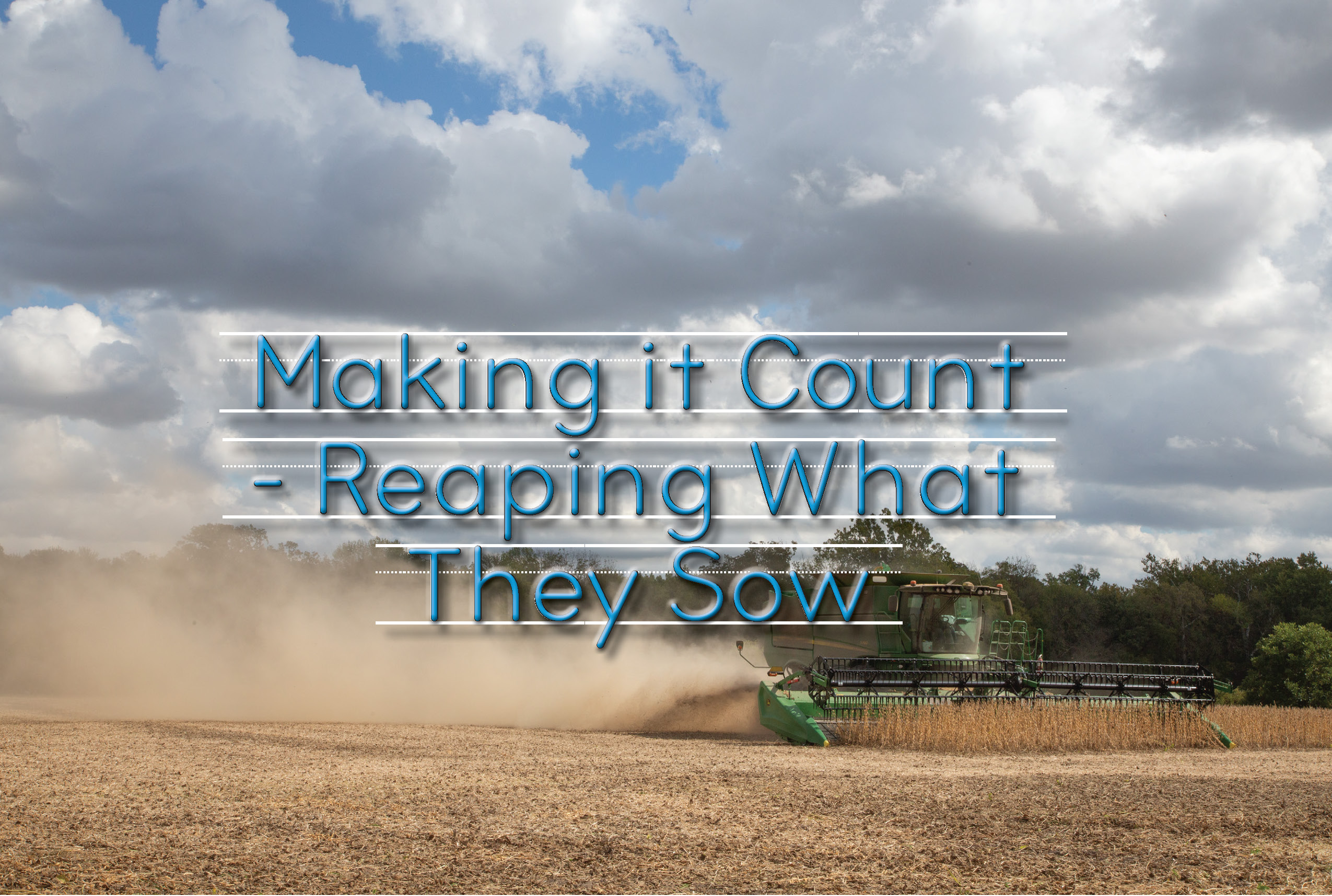| story by | |
| photos by | Steven Hertzog |
| OPEN A PDF OF THE ARTICLE |
Many factors go into running a successful farming operation, and math is key to keeping production running smoothly and ultimately making a profit.
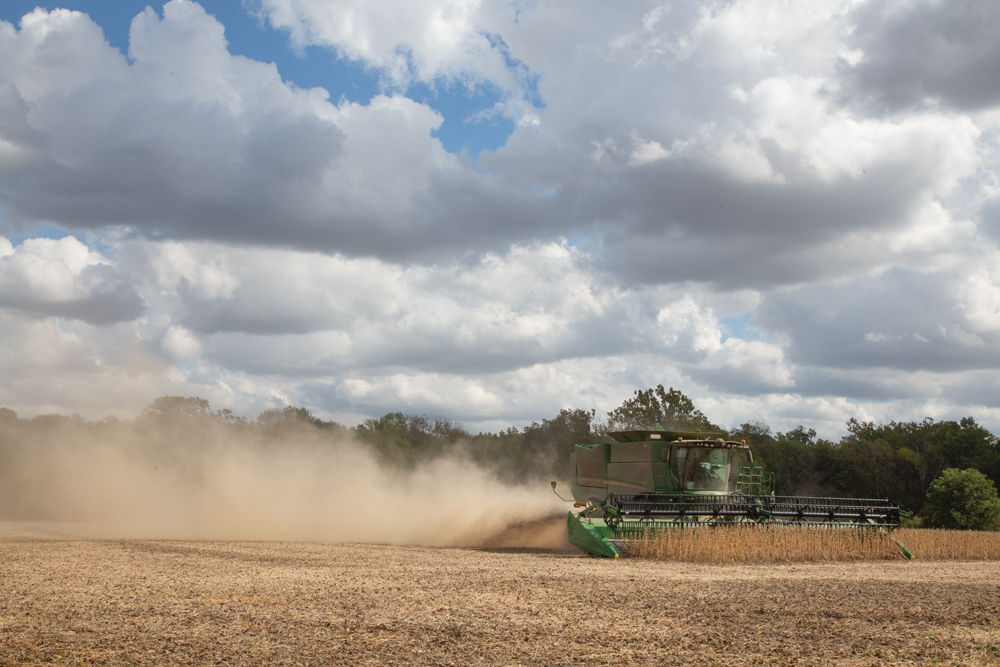
Kermit Kalb plows the fields he and his son Stephen work together.
You know autumn is coming when the nights grow cooler, days shorter and leaves prettier. Another sign? Combines chewing their way through local corn and soybean fields.
Harvest typically begins in September, and the process looks straightforward from the road. A combine’s header pulls dried stalks in, then grain is threshed, cleaned and funneled into the hopper. When the hopper is full, grain is offloaded into a waiting grain cart or truck. The grain is sold, and the cycle begins again when farmers replant fields in the spring.
Simple, right? Nope. Beef cattle and grain contributed $90 million to Douglas County’s economy in 2022, and those dollars represent countless decisions. Farmers must consider which crops to plant where and when and how best to manage those fields at each stage of growth. Those with cattle analyze everything from herd genetics, health and nutrition to the timing of breeding, calving, weaning and sales.
Producers estimate expenses and forecast yields and profits, but the twin uncertainties of markets and weather can upend those equations at any moment. There’s no way to know how the math will work out until the crops and cattle are sold.
“I’ve heard producers say farming is not a single, $1-million decision,” says Mark Dikeman, executive director of the Kansas Farm Management Association (KFMA), which is housed within Kansas State University’s department of agricultural economics and provides detailed accrual financial analysis for the farmers it works with. “It’s a million $1 decisions. If you make a significant number of good decisions over time, it will add up to profitability.”
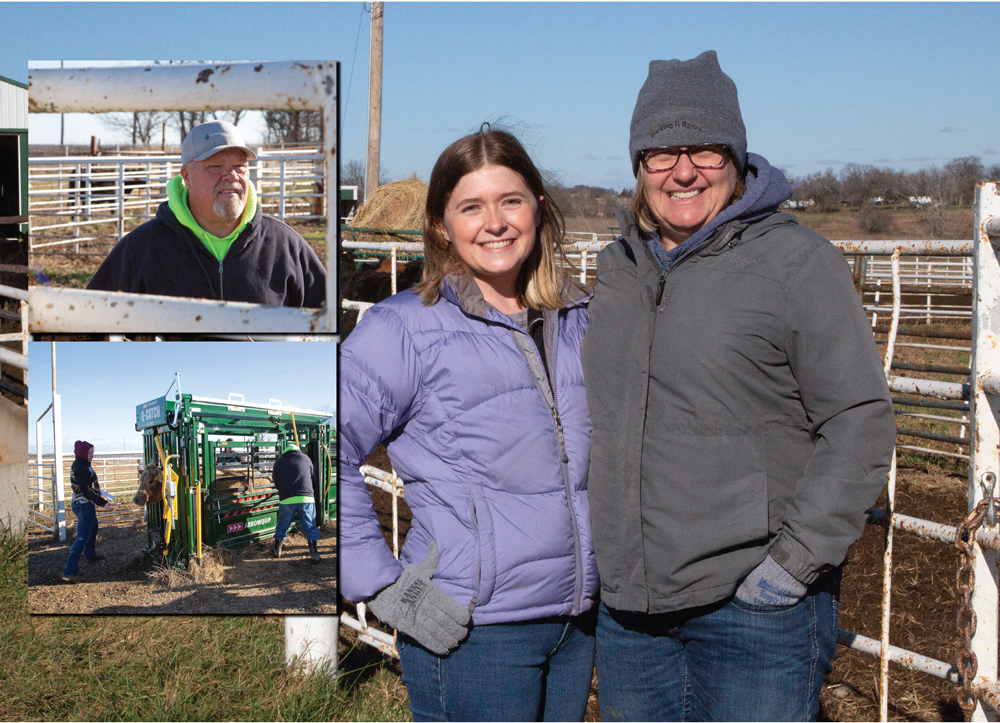
Mark Wulfkuhle framed by cattle fencing; Brenna Wulfkuhle with her daughter Baylee; The Wulfkuhle’s inspecting and treating cattle with their vet.
Quantifying the Data
Those decisions typically fall into two categories: planning production and limiting risk, and both rely on quality data and information. When it comes to planting, managing and harvesting grain, farmers have more of that at their fingertips now than ever before thanks to precision agriculture.
Precision ag combines technologies like global positioning systems (GPSs), geographic information systems (GISs) and yield monitors with software, mobile apps and other tools to track production, sometimes down to the square foot. Tractor guidance systems and autosteering, variable-rate technology for seeding and fertilizer application, and grid or zone soil-sampling allow inputs to be optimized while monitoring nutrient and water usage, weather damage, disease outbreaks, yields and more. With built-in cellular modems in their tractors and smartphones in their pockets, farmers can access that information in real time.
“Everything is a data point that can be quantified,” says Margit Kaltenekker, agriculture extension agent for K-State Research & Extension-Douglas County. “It’s all tied back to cost. What’s the payback?”
That depth of information gives producers a jump-start on planning for next season. Which varieties to plant, how much fertilizer and fuel to purchase, what equipment needs to be replaced and how to finance it, how to minimize tax liability—much of that might be plotted out six or more months before planting even begins.
The beef industry’s lead time is even longer. Cows have a gestation period of 285 days, and any bulls they have (called steers after being castrated) take at least 14 months to reach a market weight of about 1,200 to 1,400 pounds. That adds up to almost two years of care and management before seeing any return on investment.
“It takes a lot longer to know if a decision was good or bad in the cattle business,” Dikeman says.
Each cattle operation has its own goals. Some raise purebred cattle to sell as seedstock to other cattle producers. Others have crossbred commercial herds and focus solely on beef production. Either way, animals are assessed both on physical traits like size and muscling, and their genetic potential. Past performance is one way of gauging whether to keep a bull or cow in the herd. Statistics known as EPDs (expected progeny differences) can be used to estimate an animal’s ability to pass critical traits like carcass quality or reproductive ability on to offspring.
LOCAL MATTERS
Our Local Advertisers – Making a Positive Impact
And that’s only the start. Recordkeeping is essential, and producers track cows, bulls and calves through the entire production cycle. Bulls are semen-tested before being turned out with cows; artificial insemination is another breeding tool. Cows are later pregnancy-checked, and calves are weighed at birth and after being weaned at between 6 and 8 months of age.
What happens next depends on the numbers. Farmers and ranchers decide which animals to keep as replacement breeding stock and which to feed out. They calculate the expected cost of feed, forage, supplements and other inputs, and evaluate market prices and opportunities with an eye toward what it will cost to produce a pound of beef.
“There are just so many variables right now,” says Brenna Wulfkuhle. She and her husband, Mark, raise row crops and cattle on their Rocking H Ranch, in western Douglas County; they are also partners in 2BMD Farms. “Every day it seems to change for us, because you never know what you’re going to get paid. It’s all based on the market.”
Understanding Prices
How do farmers and ranchers manage that uncertainty? The first step is understanding where prices come from. Corn, soybeans, cattle and other agricultural commodities are traded as futures contracts, which are a legal agreement to buy or sell a commodity for a predetermined price at a specified time in the future.
Cash prices are what feed mills, processors, exporters and other users are willing to pay for a bushel of grain on any given day, or what buyers are paying for livestock at the area sale barn. The basis—an essential figure producers use to decide when to buy or sell—is the difference between the cash price and price of the closest futures delivery month.
Grain prices do follow cyclical patterns to some extent—they tend to drop during harvest and rise early the next year, when less is available. It’s driven by supply and demand, and anything that affects either of those practically anywhere in the world can push prices higher or lower.
For example, when the U.S. Department of Agriculture said this year’s U.S. corn harvest would total a higher-than-expected 15.2 billion bushels on Nov. 9, corn futures sank to their lowest level in almost three years. Continued disruption of exports in the Black Sea region following Russia’s invasion of Ukraine, stronger import demand from China, severe drought in Brazil (the world’s biggest soybean exporter) and even Argentina’s presidential race have each triggered price fluctuations at various times this year.
“Every little thing that happens overseas affects our market,” says Jimmy Neis, who owns Neis Bros. Farms, near Eudora, with his wife, Kelly, and his brothers and their wives, Dale and Trish Neis, and Stan and Kari Neis. They raise row crops and cattle in Douglas, Leavenworth and Johnson counties.
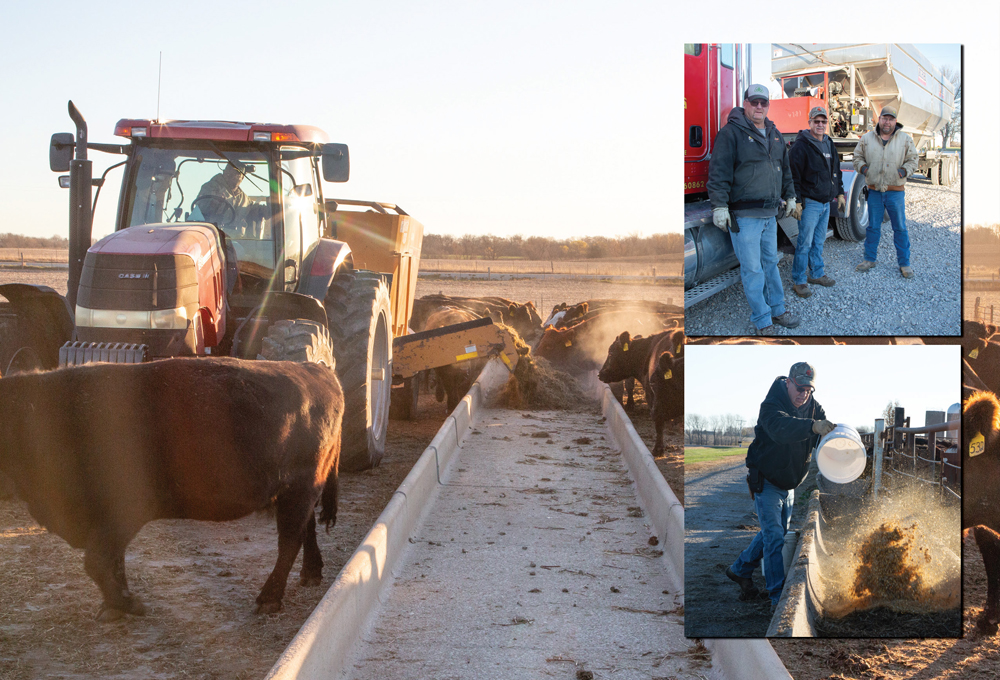
Jimmy Neis and his brothers Dale and Stan. They work their farms together sharing all the chores like tending to their cattle.
Selling Now or Later
Grain can be either sold immediately after harvest or stored to capture higher prices at a future date. That flexibility means farmers can meet local demand from end users such as East Kansas Agri-Energy, an ethanol plant in Garnett, and exporters such as The Delong Co. Inc., in Edgerton, when prices rise. They can also forward-contract with those buyers to deliver a set quantity for a certain price at a future date.
Options can also be used to hedge against losses. This type of agricultural derivative differs from futures in that they give producers the right, not the obligation, to buy or sell contracts at a specified price at any time before the contract expires. Farmers view options as protection. When they purchase an option at a certain price (known as a “put;” an option to sell is a “call”), that locks in a floor price for their crop. If the market goes up, they can let the put expire. But if prices fall, they can exercise the option to sell at that higher price.
To make all of that work, farmers must also take transportation costs and availability into account. Must they pay someone to deliver the grain, or do they have the trucks and time to haul it themselves? Storage costs must also be considered. Companies such as Cargill store grain for customers for a fee, while some producers prefer to rely on on-farm storage.
It’s all a trade-off, says Stephen Kalb, who farms with his parents, Kermit and Margaret Kalb, mostly in Douglas County, with nearby parcels in Johnson and Franklin counties.
“We have to calculate if it’s worth the storage cost to capture next year’s market bump,” says Kalb, who was a grain trader before returning to the family farm two decades ago.
Cattle markets are trickier because of the long production cycle and the fact that market-ready cattle can’t be “stored” in the same way grain can. That was especially evident in 2020, when disruptions in the meat-processing industry created a backlog of finished livestock. Producers had to shoulder continued feed and other expenses while they waited for that to clear, which cut profits.
“When COVID hit, that screwed up the whole thing, and we lost money,” says Neis, whose farm until that point retained ownership of its steers until they reached market weight. He now typically sells steers when they weigh 850 to 900 pounds.
“The last couple of years, we’ve been taking them to the sale barn and letting the next guy carry the risk,” he says.
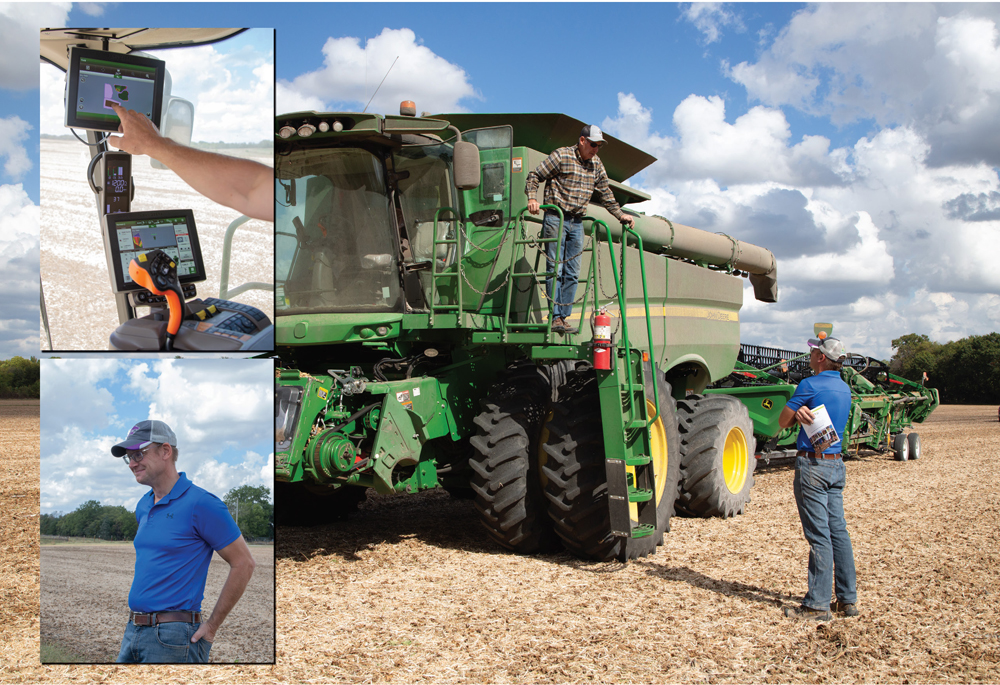
Stephen and Kermit Kalb take a break from their farm chores to discuss what else needs to get done that day; Stephen pointing to how new apps help with watering their property.
Managing Weather
Weather is another variable. There’s no stopping what comes, farmers say, but you can manage the impact. That proved challenging in 2023, the driest year to date in Douglas County for the past 129 years, according to the National Oceanic and Atmospheric Administration’s National Integrated Drought Information System.
Searing heat and spotty rainfall stressed area ponds and pastures. So instead of watering their 150 head of cattle for free from ponds, the Wulfkuhles moved part of the herd to where they could access rural water—an unexpected expense. Pastures produced less grass, which means they’ll likely start feeding hay earlier in the season than usual, Brenna Wulfkuhle says.
“Mark’s been out recounting bales of hay and figuring out how many bales we need to feed every three days to keep cows where they need to be,” she explains.
Drought also took a toll on row crops. While the corn and wheat harvests did surprisingly well, Kalb says his soybeans “never had a chance.”
“So we’re two out of three,” says Kalb, who also has cattle.
Although irrigation is an option, pivot systems are expensive, and allotments are limited. And drought is only one challenge. Too much rain at the wrong time, late freezes, hail and other weather events also cause damage. That’s where crop insurance comes in, Neis says.
“That helps you get through to the next year,” he adds.
There are two types of crop insurance. The first is through the Federal Crop Insurance Program, which offers subsidized multiple peril crop insurance to cover yield losses from natural causes like drought or disease; protection against revenue loss because of a drop in yields or prices is also available. This is regulated by the federal government and sold through private insurers. Insurance companies also sell state-regulated crop-hail policies. Other policies are available to livestock producers, as well.
It’s a significant safety net. Kansas farmers in 2022 spent $433.4 million for insurance coverage, and the industry paid $2.2 billion to cover losses from extreme weather and other factors, according to industry nonprofit National Crop Insurance Services.
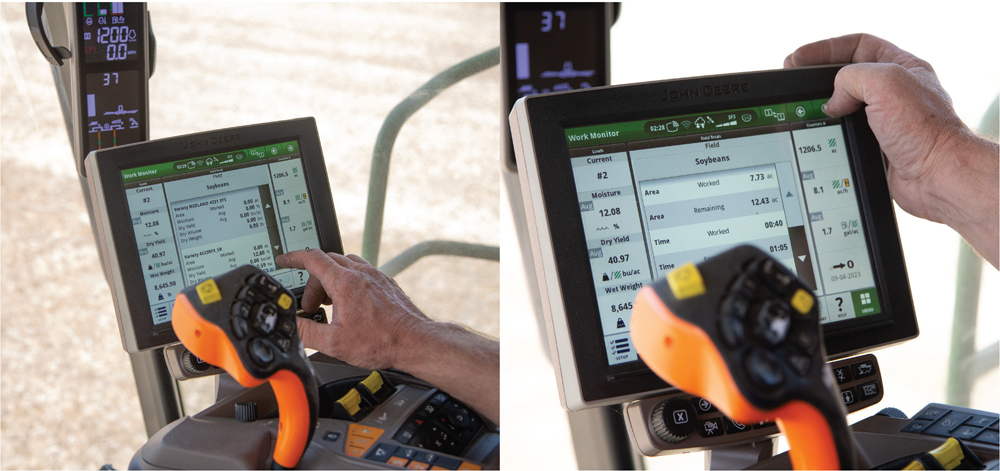 Partners in Profit
Partners in Profit
The need to constantly scrutinize all the information, prices and other details that affect the profitability of a diversified farming operation can be time-consuming. That’s why producers frequently rely on input from grain merchandisers, agronomists, nutritionists, veterinarians, accountants and other professionals.
“There are so many facets to agriculture that people don’t see,” Wulfkuhle says. “Some of those people help crunch the numbers to make those in farming and ranching more successful.”
Banks are also essential partners. Agriculture is a capital-intensive industry, one where the expenses and income typically flow during different times of year, KFMA’s Dikeman says.
“The investment to be a commercial producer is extraordinary,” he explains. “It would not be unheard of for someone to have $1½ or $2 million in equipment. That’s not even counting investments in land.”
Short-term operating loans can smooth out cash flow, while banks offer financing for bigger purchases. Ag lending is an increasingly competitive industry that includes commercial banks, the Farm Credit System and insurance companies; financing is also available from equipment manufacturers and ag product suppliers.
How farmers and ranchers interact with their lenders has changed over the past decade, Dikeman says. Banks used to look primarily at a farm’s balance sheet, issue loans based on equity and foreclose if a loan wasn’t repaid. Lenders now behave more like partners, looking closely at cash flow, a balance sheet’s debt-to-asset ratio and other financial information before making financing decisions, he continues.
It all comes back to the numbers and how well farmers and ranchers can manage the constant flow of production and financial information generated by their operations.
“Every day, (producers) are doing something with math,” Dikeman explains. “They’re always using numbers to make important management decisions.”

